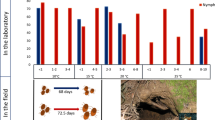Abstract
The effects of different temperatures and relative humidities (RHs) were tested on various reproductive parameters of Ornithodoros turicata, an argasid tick that inhabits gopher tortoise burrows in Florida, USA. The pre-oviposition, oviposition and incubation periods of the ticks decreased as temperature increased. These periods were also affected by the RH. The number of eggs oviposited was affected significantly by the combined effect of temperature and RH. Fewer eggs were laid by ticks in the 24°C regimes and the 27°C/95%RH regime compared to those in the other temperature/RH groups. There was an inverse relationship between the number of eggs oviposited and the percentage of hatched larvae that was correlated with the temperature and RH. Ticks reared at 27°C/90%RH and 30°C/90%RH laid more eggs than those reared in the other combinations of temperature and humidity but fewer larvae hatched from these eggs. The reproductive fitness index (RFI) values were highest in females held in the 24°C groups and the 30°C/95%RH group, although significantly more larvae hatched at the lower temperatures. The optimum reproductive conditions for O. turicata under laboratory conditions appear to be 24°C and 90–95%RH. While mating occurred at all temperatures, none of the females laid eggs at 22°C. The ticks may move preferentially to low temperatures when not feeding to remain above the critical equilibrium humidity and/or below the critical metabolic level necessary for prolonged survival. However, most female ticks oviposited after 45 days when moved to 27°C/95%RH. Ornithodoros turicata females may have a limited capability to delay oviposition until an optimal microenvironment for egg deposition can be located in the burrow.
Similar content being viewed by others
References
Adeyeye, O.A. and Butler, J.F. 1989. Population structure and seasonal intra-burrow movement of Ornithodoros turicata (Acari: Argasidae) in gopher tortoise burrows. J. Med. Entomol. 26: 279–283.
Adeyeye, O.A. and Butler, J.F. 1991. A field evaluation of carbon dioxide baits for sampling Ornithodoros turicata (Duges) in gopher tortoise habitats. J. Med. Entomol. 28: 45–48.
Bassal, T.M. and Hefnawy, T. 1972. Biochemical and physiological studies of certain ticks (Ixodidae): the effect of unfed female weight on feeding and oviposition of Hyalomma (H.) dromedarii (Ixodidae). Int. J. Parasitol. 58: 984–988.
Beck, A.F., Holscher, K.H. and Butler, J.F. 1986. Life cycle of Ornithodoros turicata americanus (Acari: Ixodidae: Argasidae) in the laboratory. J. Med. Entomol. 23: 313–319.
Bennett, G.F. 1974. Oviposition of Boophilus microplus (Canestrini) (Acarina: Ixodidae). II. Influence of temperature, humidity and light. Acarologia 16: 250–257.
Butler, J.F., Holscher, K.H., Adeyeye, O.A. and Gibbs, E.P.J. 1984. Sampling techniques for burrow dwelling ticks in reference to potential African swine fever virus vectors. In Acarology VI, Vol. 11, D.A.Griffiths and C.E.Bowman (eds), pp. 1065–1074. Ellis Horwood, West Sussex, UK.
Chilton, N.B. 1992. An index to assess the reproductive fitness of female ticks. Int. J. Parasitol. 22: 109–111.
Chilton, N.B. and Bull, C.M. 1994. Influence of environmental factors on oviposition and egg development in Amblyomma limbatum and Aponoma hydrosauri (Acari: Ixodidae). Int. J. Parasitol. 24: 83–90.
Drummond, R.O. and Whetstone, T.M. 1970. Oviposition of the Gulf Coast tick. J. Econ. Entomol. 63: 1547–1551.
ElShoura, S.M. 1987. Effects of temperature and relative humidity on the life cycle of Ornithodoros (Pavlovskyella) erraticus (Ixodidae: Argasidae). J. Parasitol. 73: 1102–1108.
Guglielmone, A.A. 1992. The effect of temperature and humidity on development and longevity of Amblyomma triguttatum triguttatum (Acarina: Ixodidae). Bull. Entomol. Res. 82: 203–208.
Heath, A.C.G. 1979. The temperature and humidity preferences of Haemaphysalis longicornis, Ixodes holocyclus and Rhipicephalus sanguineus (Ixodidae): studies on eggs. Int. J. Parasitol. 9: 33–39.
Heath, A.C.G. 1981. The temperature and humidity preferences of Haemaphysalis longicornis, Ixodes holocyclus and Rhipicephalus sanguineus (Ixodidae): studies on engorged larvae. Int. J. Parasitol. 11: 169–175.
Hueli, L.E., Garcia-Fernandez, P. and Diaz-Saez, V. 1989. Oviposition pattern and egg production efficiency of Rhipicephalus pusillus Gil Collago, 1938 in laboratory conditions (Acarina: Ixodidae). Int. J. Acarol. 15: 201–204.
Hussein, S.H. and Mustafa, B.E. 1987. Temperature and humidity effects on the life cycle of Haemaphysalis spinulosa and Rhipicephalus simus (Acari: Ixodidae). J. Med. Entomol. 24: 77–81.
Koch, H.G. 1983. Lone star ticks: oviposition, egg hatch, and molting under naturally fluctuating ambient temperatures and humidities in the field. Southwest Entomol. 8: 1–5.
Koch, H.G. and Dunn, J.C. 1980. Oviposition, egg hatch and larval survival of lone star ticks held at different temperatures and humidities. Southwest Entomol. 5: 169–173.
Ouhelli, H., Pandey, V.S. and Choukri, M. 1982. The effects of temperature, humidity, photoperiod and weight of the engorged female on oviposition of Boophilus annulatus (Say, 1821). Vet. Parasitol. 11: 231–240.
Peirce, M.A. 1974. Distribution and ecology of Ornithodoros moubata porcinus Walton (Acarina) in animal burrows in East Africa. Bull. Entomol. Res. 64: 605–619.
Phillips, J.S., Adeyeye, O.A. and Bruni, D. 1995. The respiratory metabolism of the soft tick, Ornithodoros turicata (Duges). Exp. Appl. Acarol. 19: 103–115.
Sonenshine, D.E. 1963. A preliminary report on the humidity behaviour of several species of ticks. Adv. Acarol. 1: 431–434.
Sonenshine, D.E. 1991. Biology of Ticks, Vol. 1. Oxford University Press, New York.
Sonenshine, D.E. and Tigner, J.A. 1969. Oviposition and hatching in two species of ticks in relation to moisture deficit. Ann. Entomol. Soc. Am. 62; 628–640.
Sweatman, G.K. 1967. Physical and biological factors affecting the longevity and oviposition of engorged Rhipicphalus sanguineus female ticks. J. Parasitol. 53: 432–445.
Sweatman, G.K. 1968. Temperature and humidity effects on the oviposition of Hyalomma aegyptium ticks of different engorgement weights. J. Med. Entomol. 5: 429–439.
Walton, G. 1962. The Ornithodoros moubata superspecies problem in relation to human relapsing fever epidemiology. In Aspects of disease transmission by ticks, D.R.Arthur (ed.), pp. 83–156. Zoological Society of London, London.
Winston, P.W. and Bates, D.H. 1960. Saturated solutions for the control of humidity in biological research. Ecology 41: 232–237.
Author information
Authors and Affiliations
Rights and permissions
About this article
Cite this article
Phillips, J.S., Adeyeye, O.A. Reproductive bionomics of the soft tick, Ornithodoros turicata (Acari: Argasidae). Exp Appl Acarol 20, 369–380 (1996). https://doi.org/10.1007/BF00130549
Issue Date:
DOI: https://doi.org/10.1007/BF00130549




